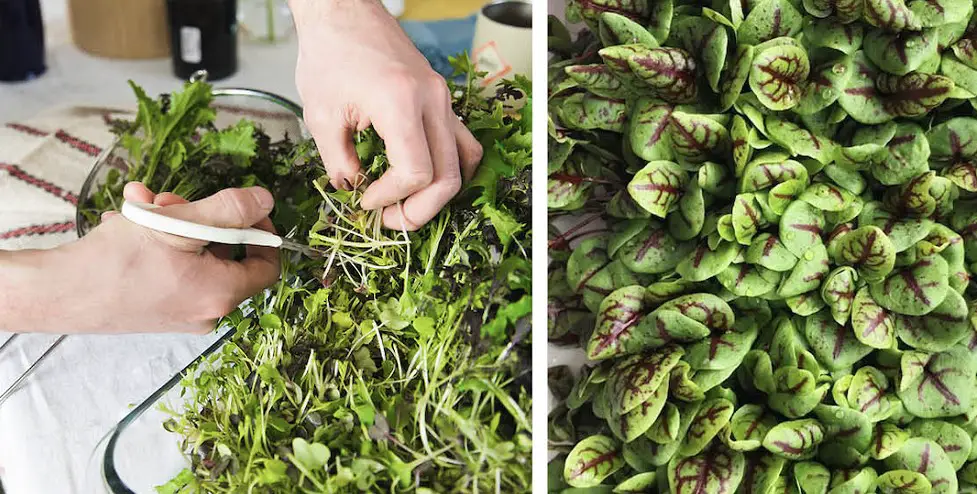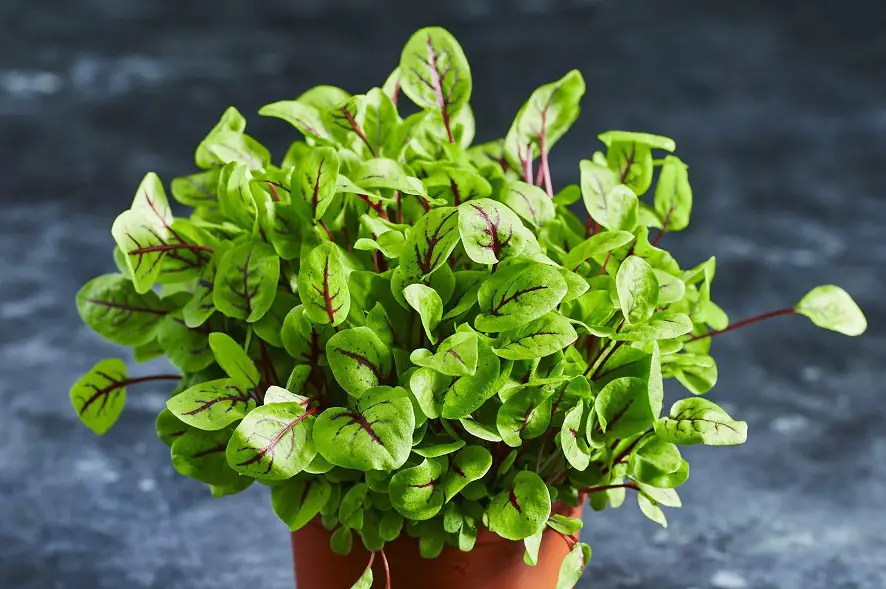With their bright-green leaves and tangy flavor, sorrel microgreens are gaining popularity among health food lovers. Being one of the slow-growing varieties, this culture is still worth cultivating due to its many benefits.

Contents
What is sorrel microgreen?
Sorrel microgreens are young, tender leaves harvested from sorrel plants at early growth stages.
Red-veined sorrel (Rumex sanguineus), also called bloody sorrel or simply red sorrel, differs in appearance from the common sorrel by its distinctive red veins.
These microgreens offer a fresh alternative to more familiar types like mustard or spinach and provide a wide range of health benefits.
Why is it good for your health?
Being of the buckwheat family, both common sorrel and red-veined sorrel, and especially their microgreens, are valued as an excellent source of vitamins, minerals, and fiber. Here are some of the sorrel’s potential benefits:
- It is rich in antioxidants, including vitamins A and C, which help to protect the body from damage caused by free radicals.
- It contains compounds with anti-inflammatory properties, which may help to reduce inflammation in the body.
- It contains oxalic acid, which stimulates digestion by helping the stomach to break down food.
- It is high in vitamin C, which boosts your immune system.
- It has been shown to have a hypotensive effect, which means it may help to reduce blood pressure.
- Sorrel is high in vitamin A, which is essential for healthy skin. It also contains compounds that may help to reduce the appearance of fine lines and wrinkles.
- It contains compounds that have been shown to have anti-cancer properties in some studies.
What does micro sorrel taste like?
Common sorrel microgreens have a somewhat sour taste and tangy flavor similar to mature plants.
What do red-veined sorrel microgreens taste like?
Compared to common sorrel microgreens, red-veined sorrel microgreens have a milder taste. It can be described as citrusy with a hint of sweetness.
How are they used in cooking?
Both common sorrel and red vein sorrel micro greens are versatile and can be used in salads, sandwiches, smoothies, and garnish.
However, their different taste profiles may make one variety more suitable than the other.
Depending on the needed intensity and flavor, they are good in such dishes as:
- Salads, for a pop of flavor and texture. They pair well with other microgreens, such as arugula, kale, and radish.
- Sandwiches, in place of lettuce or other greens. They pair well with cheese, avocado, and turkey.
- Soups, for color and flavor. They pair well with creamy tomato, potato, or mushroom soups.
- Fish and seafood, for flavorous garnish to your salmon, trout, grilled shrimp, or scallops.
- Sauces, dressings, or pesto, for texture and an extra burst of flavor.

How do you grow red-veined sorrel microgreens?
Red vein sorrel microgreens are one of the fast-growing varieties. They do not require complex growing conditions and can be harvested multiple times, making them a great compliment to any home garden or kitchen. Below are the basic steps of the direct seeding growing method.
Preparation and planting
To grow red-veined sorrel, it is not required to soak its seeds before planting.
Fill a shallow container, such as a seed tray or a plastic pan with drainage holes, with a good-quality potting mix. The recommended soil pH is around 5.5 – 6.8.
Scatter the seeds evenly over the soil surface, trying not to overcrowd them.
Cover the seeds with a thin layer of soil, about 1/4 inch deep. For this, you can use a thin layer of coconut coir as well.
Water the soil gently, being careful not to wash away the seeds.
Cover the tray with a lid or plastic film to create a mini greenhouse effect. This helps to keep the soil moist and warm for the seeds to germinate.
Germination and growth
Place the tray with seeds in a warm, well-lit area, but out of direct sunlight. Red vein sorrel plants prefer temperatures between 60 and 70 degrees Fahrenheit.
Give the seeds 3–7 days to germinate, then remove the plastic cover and put the tray in a sunny place.
Water the planted micro-sorrel from the bottom regularly, being careful not to flood the seeds.
Harvesting and storing
Red-veined sorrel plants are typically ready for harvesting after about 10–14 days in full sun when they are about 1–2 inches tall.
To harvest, use sharp scissors or a knife and cut the microgreens just above the soil level.
Rinse the harvested red veined sorrel under cool water and pat them dry with a paper towel before using them for cooking.
Sometimes you will want to cut some extra microgreens to prevent them from further growing and then put them aside to use later or share with friends.
In proper storing conditions, microgreens’ bright-green leaves remain fresh and edible for about 5 days.
It is important to keep red-veined sorrel slightly damp, but not too wet, as excess moisture can cause it to spoil quickly. Storing cut microgreens in a sealed container helps to maintain their freshness.

Conclusion
Sorrel in general, and red vein sorrel micro greens in particular, are a nutritious and flavorful addition to many dishes. These small greens pack a punch with their sharp tangy lemony flavor and are a great source of vitamins and minerals.
The growing method is relatively easy, you can grow red-veined sorrel microgreens in regular soil in your home or garden, as they require minimal care and space on window sills or garden beds.
With their versatility and health benefits, micro sorrel is a must-try for any herb enthusiast or a foodie looking to add some zest to their culinary creations.
Read More About: Micro Sorrel


